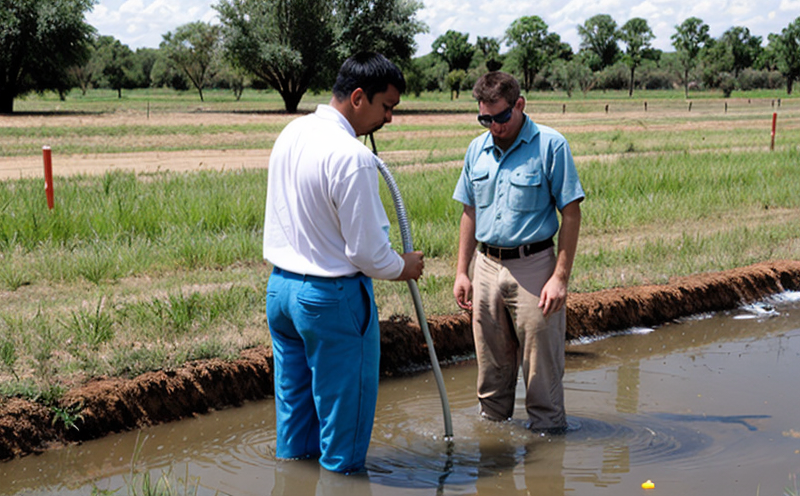ISO 6222 Heterotrophic Plate Count Test in Groundwater
The ISO 6222 Heterotrophic Plate Count (HPC) test is a critical method used to evaluate the quality and safety of groundwater samples. This test specifically quantifies heterotrophic microorganisms present in water, which are essential for assessing its overall microbiological quality.
Microbiological contamination can have serious implications on public health and environmental sustainability. Groundwater sources, especially those not treated or monitored properly, serve as a crucial resource for drinking water supply, agriculture, and industrial processes. The HPC test provides an objective measure of the microbial load in groundwater samples, thereby helping to ensure that these resources meet strict quality standards.
The procedure involves culturing the sample on a specific medium under controlled conditions over time. During this period, heterotrophic bacteria grow into visible colonies, which are then counted using standard techniques. The results are reported as colony-forming units per milliliter (CFU/mL), providing valuable insights into the microbial population present in the groundwater.
This test is particularly important for regulatory compliance and risk management purposes. It helps identify potential sources of contamination early on, allowing for timely corrective actions to be taken. Compliance with international standards such as ISO 6222 ensures that laboratory practices are consistent and reliable across different regions and organizations.
- Sample Preparation: Samples must be collected aseptically following strict protocols to prevent contamination.
- Culturing Conditions: Culturing is conducted at specific temperatures, usually 28°C or 37°C depending on the reference material used.
- Medium Selection: The use of appropriate media like tryptone soy agar (TSA) ensures optimal growth and recovery rates.
The HPC test is widely recognized for its ability to provide a comprehensive overview of microbial activity within groundwater systems. By accurately quantifying heterotrophic microorganisms, this test supports decision-making processes related to water safety, treatment efficacy evaluation, and environmental impact assessments.
Incorporating the ISO 6222 HPC test into your quality assurance program can significantly enhance confidence in the reliability of your groundwater data. It enables you to make informed decisions about resource management and protect public health against potential risks associated with microbial contamination.
Benefits
The ISO 6222 Heterotrophic Plate Count test offers numerous advantages when incorporated into environmental testing protocols. Firstly, it provides a standardized approach to measuring microbial content in groundwater samples, ensuring consistency and comparability across different laboratories.
- Standardization: Adherence to international standards like ISO 6222 ensures that results are reliable and reproducible.
- Risk Assessment: Early detection of microbial contamination allows for prompt mitigation strategies, reducing potential health hazards.
- Regulatory Compliance: Meeting stringent regulatory requirements enhances trustworthiness and credibility among stakeholders.
- Data Integrity: Accurate measurement contributes to robust data sets that support informed decision-making processes.
In addition to these practical benefits, implementing the ISO 6222 HPC test also fosters continuous improvement in laboratory practices. Regular calibration of equipment and adherence to stringent protocols contribute positively towards maintaining high-quality standards.
Why Choose This Test
Selecting the appropriate testing method is crucial for achieving accurate results that meet both regulatory expectations and internal quality control requirements. The ISO 6222 Heterotrophic Plate Count test stands out due to its robustness, precision, and wide acceptance in environmental science.
One key advantage lies in its ability to detect even low levels of heterotrophic bacteria, making it an excellent tool for monitoring pristine groundwater resources. This sensitivity ensures that no significant microbial presence goes undetected, which is particularly beneficial during initial surveys or when dealing with sensitive ecosystems.
The test's compatibility with various types of groundwater samples further expands its applicability. Whether it’s fresh water, brackish water, or even contaminated sources being cleaned up, the ISO 6222 HPC method remains effective in quantifying bacterial populations.
Another compelling reason for choosing this test is its strong correlation with public health outcomes. High levels of heterotrophic bacteria have been linked to increased incidences of gastrointestinal diseases among communities relying on such water sources. Therefore, ensuring low bacterial counts through rigorous testing helps safeguard human health and well-being.
Moreover, by opting for the ISO 6222 HPC test, organizations demonstrate their commitment to environmental stewardship and responsible resource management. Compliance with international standards like this one not only meets legal obligations but also establishes a reputation as a leader in sustainable practices.
Quality and Reliability Assurance
Ensuring the quality and reliability of laboratory testing is paramount for maintaining credibility and trust. At our facility, we employ stringent measures to uphold these standards throughout every stage of the ISO 6222 Heterotrophic Plate Count test.
- Calibration: All instrumentation used in this process undergoes regular calibration against recognized standards.
- Aseptic Technique: Strict aseptic techniques are followed during sample collection and handling to minimize cross-contamination risks.
- Standard Operating Procedures (SOPs): Comprehensive SOPs guide all personnel involved in executing the test, ensuring uniformity in procedure application.
- Data Verification: Results obtained from each batch of samples are independently verified before finalization to catch any discrepancies promptly.
We also participate actively in proficiency testing programs organized by recognized bodies to validate our ongoing performance. This proactive approach helps identify areas needing improvement and reinforces our commitment to excellence.





